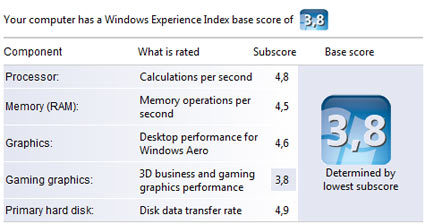Can Your PC Really Handle Vista?
Windows Vista Experience Index
Windows Vista has a built-in benchmarking feature, which allows to not only assess system performance, but it returns an experience index for the entire system. It is based on typical workloads and checks component features and performance. The results are individual performance indices for several key components:
- Processor (calculations per second)
- RAM (memory operations per second)
- Graphics (performance for AeroGlass interface)
- Gaming Graphics (3D graphics performance)
- System hard drive (data transfer rate)
Each component can score between 1 and 6, while scores up to 5.0 are displayed in .5 increments, while 5.1 and up is broken down into .1 increments. According to Microsoft, scores above 6 are possible with future hardware, which makes the Experience Index a pretty powerful tool to compare component performance across the board.
We aren't sure if Microsoft's way of calculating the Experience Index is ideal, since there isn't much calculation involved. Instead, Windows Vista takes the lowest of the five individual results and makes it the overall Experience Index for your system. On the one hand it will always make pretty clear shortcomings by showing a disappointing overall score, but it ignores that the components that may be important for you can be more than suitable.
I'm currently working on a Lenovo T60 Thinkpad 2007-FUGE, which is based on a Core 2 Duo T5600 processor (1.83 GHz dual core), two 1 GB DDR2-667 DIMMs, an Intel 945M mobile chipset and ATI's Mobility Radeon X1400 with discreet graphics, plus a Seagate Momentus 7200.1 hard drive, which runs at 7,200 RPM. Apart from the graphics subsystem, most people would agree that the setup is pretty powerful, but Vista's performance index is "only" 3.8. If it weren't for the graphics card, the system would score at least 4.5 points. For me, since I do not play games on this machine at all, graphics performance is secondary. The Mobility Radeon X1400 has its dedicated 128 MB of memory and it is Direct X9.0c compliant - that's all I wanted for my mobile workhorse. Anyways, my message is that it is important to have an eye on component indices before making a computer purchase based on the overall Experience Index.
This is a screenshot of the Windows Vista Experience Index for a Lenovo Thinkpad T60 2007-FUGE notebook. This device has a Core 2 Duo T5600 processor (1.86 GHz), 2x 1 GB DDR2-667 RAM at CL5-5-5-15 timings, an ATI Mobility Radeon X1400 with 128 MB discrete graphics memory and a Seagate Momentus 7200.1, which runs at 7.200 RPM. As you can see, the gaming graphics index is the lowest individual result and it dominates the Vista Experience Index. Since all other scores are considerably higher, this notebook is more suitable for office and multimedia than it is for gaming.
Get Tom's Hardware's best news and in-depth reviews, straight to your inbox.

Patrick Schmid was the editor-in-chief for Tom's Hardware from 2005 to 2006. He wrote numerous articles on a wide range of hardware topics, including storage, CPUs, and system builds.
